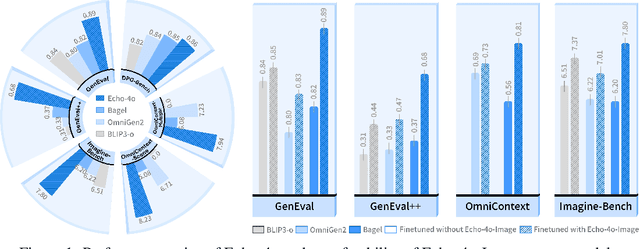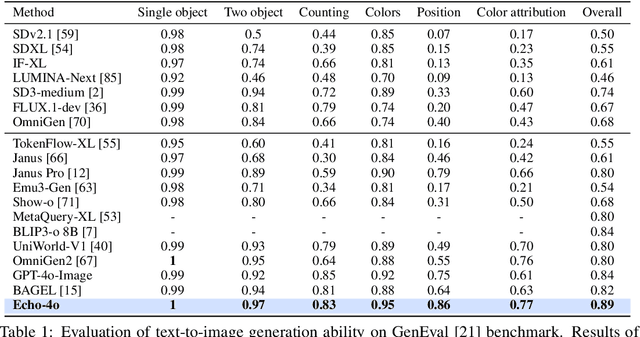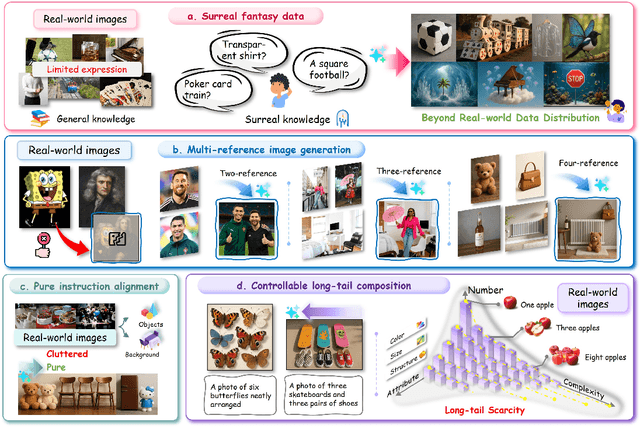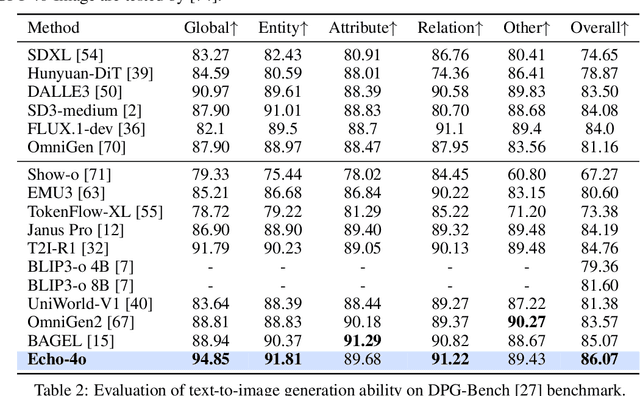Zhiyuan Yan
Beyond Artifacts: Real-Centric Envelope Modeling for Reliable AI-Generated Image Detection
Dec 24, 2025Abstract:The rapid progress of generative models has intensified the need for reliable and robust detection under real-world conditions. However, existing detectors often overfit to generator-specific artifacts and remain highly sensitive to real-world degradations. As generative architectures evolve and images undergo multi-round cross-platform sharing and post-processing (chain degradations), these artifact cues become obsolete and harder to detect. To address this, we propose Real-centric Envelope Modeling (REM), a new paradigm that shifts detection from learning generator artifacts to modeling the robust distribution of real images. REM introduces feature-level perturbations in self-reconstruction to generate near-real samples, and employs an envelope estimator with cross-domain consistency to learn a boundary enclosing the real image manifold. We further build RealChain, a comprehensive benchmark covering both open-source and commercial generators with simulated real-world degradation. Across eight benchmark evaluations, REM achieves an average improvement of 7.5% over state-of-the-art methods, and notably maintains exceptional generalization on the severely degraded RealChain benchmark, establishing a solid foundation for synthetic image detection under real-world conditions. The code and the RealChain benchmark will be made publicly available upon acceptance of the paper.
Can Understanding and Generation Truly Benefit Together -- or Just Coexist?
Sep 11, 2025



Abstract:In this paper, we introduce an insightful paradigm through the Auto-Encoder lens-understanding as the encoder (I2T) that compresses images into text, and generation as the decoder (T2I) that reconstructs images from that text. Using reconstruction fidelity as the unified training objective, we enforce the coherent bidirectional information flow between the understanding and generation processes, bringing mutual gains. To implement this, we propose UAE, a novel framework for unified multimodal learning. We begin by pre-training the decoder with large-scale long-context image captions to capture fine-grained semantic and complex spatial relationships. We then propose Unified-GRPO via reinforcement learning (RL), which covers three stages: (1) A cold-start phase to gently initialize both encoder and decoder with a semantic reconstruction loss; (2) Generation for Understanding, where the encoder is trained to generate informative captions that maximize the decoder's reconstruction quality, enhancing its visual understanding; (3) Understanding for Generation, where the decoder is refined to reconstruct from these captions, forcing it to leverage every detail and improving its long-context instruction following and generation fidelity. For evaluation, we introduce Unified-Bench, the first benchmark tailored to assess the degree of unification of the UMMs. A surprising "aha moment" arises within the multimodal learning domain: as RL progresses, the encoder autonomously produces more descriptive captions, while the decoder simultaneously demonstrates a profound ability to understand these intricate descriptions, resulting in reconstructions of striking fidelity.
Echo-4o: Harnessing the Power of GPT-4o Synthetic Images for Improved Image Generation
Aug 13, 2025



Abstract:Recently, GPT-4o has garnered significant attention for its strong performance in image generation, yet open-source models still lag behind. Several studies have explored distilling image data from GPT-4o to enhance open-source models, achieving notable progress. However, a key question remains: given that real-world image datasets already constitute a natural source of high-quality data, why should we use GPT-4o-generated synthetic data? In this work, we identify two key advantages of synthetic images. First, they can complement rare scenarios in real-world datasets, such as surreal fantasy or multi-reference image generation, which frequently occur in user queries. Second, they provide clean and controllable supervision. Real-world data often contains complex background noise and inherent misalignment between text descriptions and image content, whereas synthetic images offer pure backgrounds and long-tailed supervision signals, facilitating more accurate text-to-image alignment. Building on these insights, we introduce Echo-4o-Image, a 180K-scale synthetic dataset generated by GPT-4o, harnessing the power of synthetic image data to address blind spots in real-world coverage. Using this dataset, we fine-tune the unified multimodal generation baseline Bagel to obtain Echo-4o. In addition, we propose two new evaluation benchmarks for a more accurate and challenging assessment of image generation capabilities: GenEval++, which increases instruction complexity to mitigate score saturation, and Imagine-Bench, which focuses on evaluating both the understanding and generation of imaginative content. Echo-4o demonstrates strong performance across standard benchmarks. Moreover, applying Echo-4o-Image to other foundation models (e.g., OmniGen2, BLIP3-o) yields consistent performance gains across multiple metrics, highlighting the datasets strong transferability.
Beyond Chemical QA: Evaluating LLM's Chemical Reasoning with Modular Chemical Operations
May 27, 2025Abstract:While large language models (LLMs) with Chain-of-Thought (CoT) reasoning excel in mathematics and coding, their potential for systematic reasoning in chemistry, a domain demanding rigorous structural analysis for real-world tasks like drug design and reaction engineering, remains untapped. Current benchmarks focus on simple knowledge retrieval, neglecting step-by-step reasoning required for complex tasks such as molecular optimization and reaction prediction. To address this, we introduce ChemCoTBench, a reasoning framework that bridges molecular structure understanding with arithmetic-inspired operations, including addition, deletion, and substitution, to formalize chemical problem-solving into transparent, step-by-step workflows. By treating molecular transformations as modular "chemical operations", the framework enables slow-thinking reasoning, mirroring the logic of mathematical proofs while grounding solutions in real-world chemical constraints. We evaluate models on two high-impact tasks: Molecular Property Optimization and Chemical Reaction Prediction. These tasks mirror real-world challenges while providing structured evaluability. By providing annotated datasets, a reasoning taxonomy, and baseline evaluations, ChemCoTBench bridges the gap between abstract reasoning methods and practical chemical discovery, establishing a foundation for advancing LLMs as tools for AI-driven scientific innovation.
Guard Me If You Know Me: Protecting Specific Face-Identity from Deepfakes
May 26, 2025Abstract:Securing personal identity against deepfake attacks is increasingly critical in the digital age, especially for celebrities and political figures whose faces are easily accessible and frequently targeted. Most existing deepfake detection methods focus on general-purpose scenarios and often ignore the valuable prior knowledge of known facial identities, e.g., "VIP individuals" whose authentic facial data are already available. In this paper, we propose \textbf{VIPGuard}, a unified multimodal framework designed to capture fine-grained and comprehensive facial representations of a given identity, compare them against potentially fake or similar-looking faces, and reason over these comparisons to make accurate and explainable predictions. Specifically, our framework consists of three main stages. First, fine-tune a multimodal large language model (MLLM) to learn detailed and structural facial attributes. Second, we perform identity-level discriminative learning to enable the model to distinguish subtle differences between highly similar faces, including real and fake variations. Finally, we introduce user-specific customization, where we model the unique characteristics of the target face identity and perform semantic reasoning via MLLM to enable personalized and explainable deepfake detection. Our framework shows clear advantages over previous detection works, where traditional detectors mainly rely on low-level visual cues and provide no human-understandable explanations, while other MLLM-based models often lack a detailed understanding of specific face identities. To facilitate the evaluation of our method, we built a comprehensive identity-aware benchmark called \textbf{VIPBench} for personalized deepfake detection, involving the latest 7 face-swapping and 7 entire face synthesis techniques for generation.
ImgEdit: A Unified Image Editing Dataset and Benchmark
May 26, 2025Abstract:Recent advancements in generative models have enabled high-fidelity text-to-image generation. However, open-source image-editing models still lag behind their proprietary counterparts, primarily due to limited high-quality data and insufficient benchmarks. To overcome these limitations, we introduce ImgEdit, a large-scale, high-quality image-editing dataset comprising 1.2 million carefully curated edit pairs, which contain both novel and complex single-turn edits, as well as challenging multi-turn tasks. To ensure the data quality, we employ a multi-stage pipeline that integrates a cutting-edge vision-language model, a detection model, a segmentation model, alongside task-specific in-painting procedures and strict post-processing. ImgEdit surpasses existing datasets in both task novelty and data quality. Using ImgEdit, we train ImgEdit-E1, an editing model using Vision Language Model to process the reference image and editing prompt, which outperforms existing open-source models on multiple tasks, highlighting the value of ImgEdit and model design. For comprehensive evaluation, we introduce ImgEdit-Bench, a benchmark designed to evaluate image editing performance in terms of instruction adherence, editing quality, and detail preservation. It includes a basic testsuite, a challenging single-turn suite, and a dedicated multi-turn suite. We evaluate both open-source and proprietary models, as well as ImgEdit-E1, providing deep analysis and actionable insights into the current behavior of image-editing models. The source data are publicly available on https://github.com/PKU-YuanGroup/ImgEdit.
CAD: A General Multimodal Framework for Video Deepfake Detection via Cross-Modal Alignment and Distillation
May 21, 2025Abstract:The rapid emergence of multimodal deepfakes (visual and auditory content are manipulated in concert) undermines the reliability of existing detectors that rely solely on modality-specific artifacts or cross-modal inconsistencies. In this work, we first demonstrate that modality-specific forensic traces (e.g., face-swap artifacts or spectral distortions) and modality-shared semantic misalignments (e.g., lip-speech asynchrony) offer complementary evidence, and that neglecting either aspect limits detection performance. Existing approaches either naively fuse modality-specific features without reconciling their conflicting characteristics or focus predominantly on semantic misalignment at the expense of modality-specific fine-grained artifact cues. To address these shortcomings, we propose a general multimodal framework for video deepfake detection via Cross-Modal Alignment and Distillation (CAD). CAD comprises two core components: 1) Cross-modal alignment that identifies inconsistencies in high-level semantic synchronization (e.g., lip-speech mismatches); 2) Cross-modal distillation that mitigates feature conflicts during fusion while preserving modality-specific forensic traces (e.g., spectral distortions in synthetic audio). Extensive experiments on both multimodal and unimodal (e.g., image-only/video-only)deepfake benchmarks demonstrate that CAD significantly outperforms previous methods, validating the necessity of harmonious integration of multimodal complementary information.
Dual Data Alignment Makes AI-Generated Image Detector Easier Generalizable
May 20, 2025Abstract:Existing detectors are often trained on biased datasets, leading to the possibility of overfitting on non-causal image attributes that are spuriously correlated with real/synthetic labels. While these biased features enhance performance on the training data, they result in substantial performance degradation when applied to unbiased datasets. One common solution is to perform dataset alignment through generative reconstruction, matching the semantic content between real and synthetic images. However, we revisit this approach and show that pixel-level alignment alone is insufficient. The reconstructed images still suffer from frequency-level misalignment, which can perpetuate spurious correlations. To illustrate, we observe that reconstruction models tend to restore the high-frequency details lost in real images (possibly due to JPEG compression), inadvertently creating a frequency-level misalignment, where synthetic images appear to have richer high-frequency content than real ones. This misalignment leads to models associating high-frequency features with synthetic labels, further reinforcing biased cues. To resolve this, we propose Dual Data Alignment (DDA), which aligns both the pixel and frequency domains. Moreover, we introduce two new test sets: DDA-COCO, containing DDA-aligned synthetic images for testing detector performance on the most aligned dataset, and EvalGEN, featuring the latest generative models for assessing detectors under new generative architectures such as visual auto-regressive generators. Finally, our extensive evaluations demonstrate that a detector trained exclusively on DDA-aligned MSCOCO could improve across 8 diverse benchmarks by a non-trivial margin, showing a +7.2% on in-the-wild benchmarks, highlighting the improved generalizability of unbiased detectors.
A Complex-valued SAR Foundation Model Based on Physically Inspired Representation Learning
Apr 16, 2025Abstract:Vision foundation models in remote sensing have been extensively studied due to their superior generalization on various downstream tasks. Synthetic Aperture Radar (SAR) offers all-day, all-weather imaging capabilities, providing significant advantages for Earth observation. However, establishing a foundation model for SAR image interpretation inevitably encounters the challenges of insufficient information utilization and poor interpretability. In this paper, we propose a remote sensing foundation model based on complex-valued SAR data, which simulates the polarimetric decomposition process for pre-training, i.e., characterizing pixel scattering intensity as a weighted combination of scattering bases and scattering coefficients, thereby endowing the foundation model with physical interpretability. Specifically, we construct a series of scattering queries, each representing an independent and meaningful scattering basis, which interact with SAR features in the scattering query decoder and output the corresponding scattering coefficient. To guide the pre-training process, polarimetric decomposition loss and power self-supervision loss are constructed. The former aligns the predicted coefficients with Yamaguchi coefficients, while the latter reconstructs power from the predicted coefficients and compares it to the input image's power. The performance of our foundation model is validated on six typical downstream tasks, achieving state-of-the-art results. Notably, the foundation model can extract stable feature representations and exhibits strong generalization, even in data-scarce conditions.
From Specificity to Generality: Revisiting Generalizable Artifacts in Detecting Face Deepfakes
Apr 07, 2025Abstract:Detecting deepfakes has been an increasingly important topic, especially given the rapid development of AI generation techniques. In this paper, we ask: How can we build a universal detection framework that is effective for most facial deepfakes? One significant challenge is the wide variety of deepfake generators available, resulting in varying forgery artifacts (e.g., lighting inconsistency, color mismatch, etc). But should we ``teach" the detector to learn all these artifacts separately? It is impossible and impractical to elaborate on them all. So the core idea is to pinpoint the more common and general artifacts across different deepfakes. Accordingly, we categorize deepfake artifacts into two distinct yet complementary types: Face Inconsistency Artifacts (FIA) and Up-Sampling Artifacts (USA). FIA arise from the challenge of generating all intricate details, inevitably causing inconsistencies between the complex facial features and relatively uniform surrounding areas. USA, on the other hand, are the inevitable traces left by the generator's decoder during the up-sampling process. This categorization stems from the observation that all existing deepfakes typically exhibit one or both of these artifacts. To achieve this, we propose a new data-level pseudo-fake creation framework that constructs fake samples with only the FIA and USA, without introducing extra less-general artifacts. Specifically, we employ a super-resolution to simulate the USA, while design a Blender module that uses image-level self-blending on diverse facial regions to create the FIA. We surprisingly found that, with this intuitive design, a standard image classifier trained only with our pseudo-fake data can non-trivially generalize well to unseen deepfakes.
 Add to Chrome
Add to Chrome Add to Firefox
Add to Firefox Add to Edge
Add to Edge